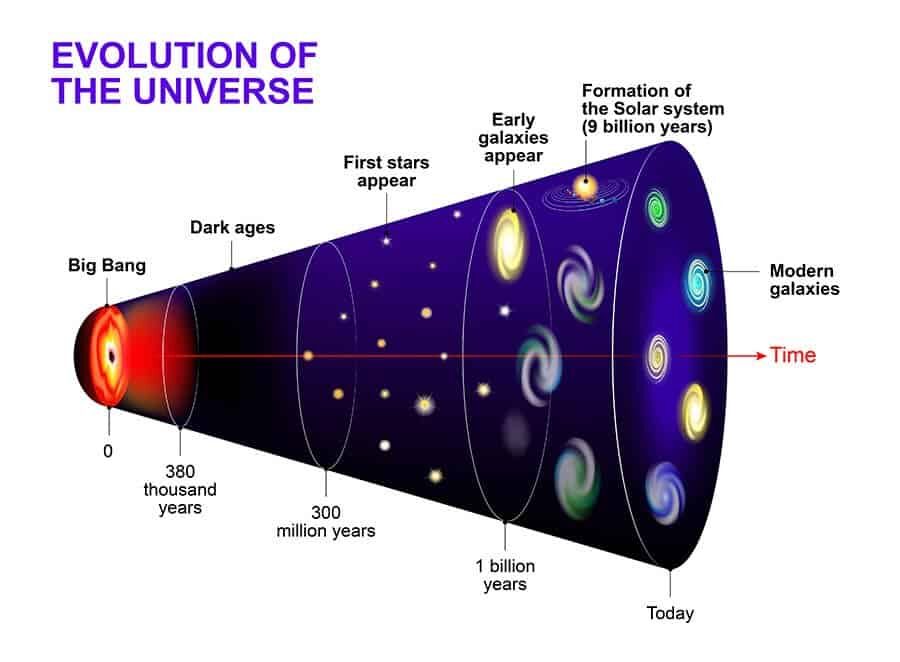Big Bang Facts | Interesting Facts about the Big Bang Theory
The Big Bang is one of the most fascinating things about our entire universe. In fact, when you sit down and think about it, it can be a little overwhelming! Although however fascinating it may seem, astronomers and scientists believe it to me the most viable way that our universe as we know it formed.
It’s thought that everything we see, from the Sun to the Stars to distant galaxies, they were all created by this one expansion – that is, if you believe the Big Bang theory. Let’s look at some facts about how the universe was created.
- The Big Bang occurred more than 13.8 million years ago. It created much of our current universe, but stars were not present in the early universe, instead forming more than 100 million years after the initial event.
- Our current universe as we know it is expanding. As it expands, our galaxies distance themselves from one another. However, the Big Bang theory explains that this was less of a “bang”, and more of an expansion.
- Originally, everything in our universe was compressed into one tiny dot. Out of this dot expanded into the universe, as originally the early universe was much smaller.
- The Belgian Priest Georges Lemaître is credited with first theorizing the Big Bang back in the 1920s. Lemaître thought that our universe as we know it must still be expanding.
- Although discovered by Lemaître, the term Big Bang was coined by English astronomer Fred Hoyle.
- However, it wasn’t until the 1940s and 50s that the theory really took off with many astronomers considering it a possibility.
- We don’t know of anything existing earlier than the formation of our universe, but it is definitely a possibility.
- The heat present in the earlier times of the universe is the reason for all of the hydrogen, helium and many other gases that are present.
- Although we know that ideas about the Big Bang theory were derived from Einstein, he didn’t believe the theory could be correct. Einstein’s general theory did bring up the idea of an expanding universe though.
- It wasn’t until 9 billion years after the Big Bang that our solar system was formed, as our planet and Sun is actually relatively young in comparison to the whole universe.
- As the galaxies are moving away from each other, eventually they will become invisible to us.
- Hand in hand with the Big Bang model comes the theories about the expansion of the universe. This kind of explains how we were formed from such a small space, and why galaxies move over time.
- It’s thought that the universe will either eventually freeze due to its expansion, or there will be so much mass in the universe that it will retract back into itself.
- The Cosmic Microwave Background Radiation, often referred to as the CMB, is leftover radiation from the initial Big Bang, and often used as part of any leading theory as to proof of the Big Bang’s existence.
Whilst it’s true that the stars and galaxies were not formed with the Big Bang, more activity occurred in the seconds after the Big Bang than the billions of years after it happened. For many years, there were no stars, no galaxies and definitely no solar system. Most of the universe was made up of dark matter, and even today if we look at dark matter, it still makes up a good amount of the whole universe.

The first stars were formed approximately 300 million years after the universe was created, and it was 700 million years until the first galaxies were formed. the solar system was formed 9 billion years after the universe began.
One of the most common questions about the Big Bang is how did it occur. We know that it expanded from an atom sized dot, but how did that dot get there? The truth of this is, we actually don’t know. You might see various theories about this, but the reality is that scientists just aren’t sure how the Big Bang really started.
The Big Bang happened 13.8 billion years ago, and within a few seconds our universe was formed. However, it wasn’t until hundreds of millions of years later that the stars and galaxies were formed.
Although it’s spoken as fact-like by astronomers, the truth is that the Big Bang actually isn’t a factual truth that we’re 100% sure of. However, based on everything else we know about our universe, it seems the most likely circumstance.
The reason why the Big Bang theory really caught on was Hubble’s discovery of the universe expanding. It wasn’t until this that astronomers really accepted the theory of the Big Bang.
There actually is no center of the Big Bang. There is no edge to our universe, and theoretically if one person travelled North, and another travelled South, the two would never meet as there is no center and no edge either.
To sum it up, the Big Bang is still one of the most unknown components of our knowledge about the universe and its creation. Although just a theory, in the last few decades recent discoveries have confirmed and aligned with the theory, with many astronomers believing it to be fact. Hopefully, you’ve learned something new about the Big Bang!